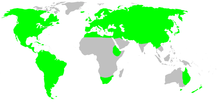Amaurobiidae
| Tangled nest spiders Temporal range:
| |
|---|---|

| |
| Callobius sp. | |

| |
| Pimus sp. | |
| Scientific classification | |
| Domain: | Eukaryota |
| Kingdom: | Animalia |
| Phylum: | Arthropoda |
| Subphylum: | Chelicerata |
| Class: | Arachnida |
| Order: | Araneae |
| Infraorder: | Araneomorphae |
| Family: | Amaurobiidae Thorell, 1869 |
| Diversity | |
| 50 genera, 286 species | |

| |
Amaurobiidae is a family of three-clawed cribellate or ecribellate spiders found in crevices and hollows or under stones where they build retreats, and are often collected in pitfall traps. Unlidded burrows are sometimes quite obvious in crusty, loamy soil.[1][2] They are difficult to distinguish from related spiders in other families, especially Agelenidae, Desidae and Amphinectidae. Their intra- and interfamilial relationships are contentious. According to the World Spider Catalog, 2023, the family Amaurobiidae includes 286 species in 50 genera.[3]
In Australia, they are small to medium-sized entelegyne spiders with minimal sheet webs.[2] They are fairly common in Tasmania and nearby mainland Australia in cooler rainforest, some in caves. They are widespread but uncommon along the eastern coastline. They generally have eight similar eyes in two conservatively curved rows. They often have a calamistrum on metatarsus IV associated with a cribellum. Australian amaurobiids may be distinguished from the Amphinectidae by the absence of a pretarsal fracture and the presence of a retrocoxal hymen on coxa I.[4]
Reorganization
[edit]This family has lost and gained several genera resulting from wide-ranging DNA analysis of spider families. It lost Bakala and Manjala to Desidae, while Toxopidae took in Midgee and the monotypic genus Jamara. It also lost some of Australia's medium-sized brown spiders including Tasmabrochus, Tasmarubrius, and Teeatta) to Macrobinidae[5], all of which are claimed to be common in Tasmania and mainland Australia but are rarely seen or recorded. The lack of research replicability and absence of photographic proof in species and genus diagnosis has resulted in low performance in computer recognition models and citizen science platforms for these genera. No open access visual records exist for Teeatta [6], nor for Oztira[7].
Genera
[edit]As of January 2023[update], the World Spider Catalog accepts the following genera:[3]
- Altellopsis Simon, 1905 — Argentina
- Amaurobius C. L. Koch, 1837 — North America, South America, Europe, Africa, Georgia, Micronesia
- Anisacate Mello-Leitão, 1941 — Argentina, Chile
- Arctobius Lehtinen, 1967 — United States, Canada, Russia
- Auhunga Forster & Wilton, 1973 — New Zealand
- Auximella Strand, 1908 — Ecuador, Brazil, Peru
- Callevopsis Tullgren, 1902 — Chile, Argentina
- Callobius Chamberlin, 1947 — North America, Bulgaria, Asia
- Cavernocymbium Ubick, 2005 — United States
- Chresiona Simon, 1903 — South Africa
- Chumma Jocqué, 2001 — South Africa, Lesotho
- Cybaeopsis Strand, 1907 — North America, Asia
- Dardurus Davies, 1976 — Australia
- Daviesa Koçak & Kemal, 2008 — Australia
- Ecurobius Zamani & Marusik, 2021 — Iran
- Emmenomma Simon, 1884 — Argentina, Chile
- Hicanodon Tullgren, 1901 — Chile, Argentina
- Himalmartensus Wang & Zhu, 2008 — Nepal, India
- Livius Roth, 1967 — Chile
- Macrobunus Tullgren, 1901 — Chile, Argentina, South Africa
- Malenella Ramírez, 1995 — Chile
- Maloides Forster & Wilton, 1989 — New Zealand
- Muritaia Forster & Wilton, 1973 — New Zealand
- Naevius Roth, 1967 — Argentina, Peru, Bolivia
- Neoporteria Mello-Leitão, 1943 — Chile
- Neuquenia Mello-Leitão, 1940 — Argentina
- Obatala Lehtinen, 1967 — South Africa
- Otira Forster & Wilton, 1973 — New Zealand
- Ovtchinnikovia Marusik, Kovblyuk & Ponomarev, 2010
- Oztira Milledge, 2011 — Australia
- Parazanomys Ubick, 2005 — United States
- Pimus Chamberlin, 1947 — United States
- Pseudauximus Simon, 1902 — South Africa
- Retiro Mello-Leitão, 1915 — South America, Costa Rica
- Rhoicinaria Exline, 1950 — Colombia, Ecuador
- Rubrius Simon, 1887 — Chile, Argentina
- Storenosoma Hogg, 1900 — Australia
- Taira Lehtinen, 1967 — China, Japan
- Tasmabrochus Davies, 2002 — Australia
- Tasmarubrius Davies, 1998 — Australia
- Teeatta Davies, 2005 — Australia
- Tugana Chamberlin, 1948 — Cuba
- Tymbira Mello-Leitão, 1944 — Argentina
- Urepus Roth, 1967 — Peru
- Virgilus Roth, 1967 — Ecuador
- Wabarra Davies, 1996 — Australia
- Waitetola Forster & Wilton, 1973 — New Zealand
- Yacolla Lehtinen, 1967 — Brazil
- Yupanquia Lehtinen, 1967 — Argentina
- Zanomys Chamberlin, 1948 — United States, Canada
See also
[edit]References
[edit]- ^ "Amaurobiidae Hackled-mesh Weavers". www.arachne.org.au. Retrieved 2019-03-20.
- ^ a b Whyte, Robert; Anderson, Greg (June 2017). A field guide to spiders of Australia. Clayton, Vic. ISBN 9780643107083. OCLC 973390260.
{{cite book}}: CS1 maint: location missing publisher (link) - ^ a b "Family: Amaurobiidae Thorell, 1870". World Spider Catalog. Natural History Museum Bern. Retrieved 2023-01-19.
- ^ [1] Spiders of Australia Archived 2011-11-30 at the Wayback Machine
- ^ https://wsc.nmbe.ch/family/165/Macrobunidae
- ^ https://www.inaturalist.org/observations?taxon_id=418864
- ^ https://bie.ala.org.au/species/https://biodiversity.org.au/afd/taxa/4909bfd0-c9c1-4e76-a880-be6982e7c246#gallery
